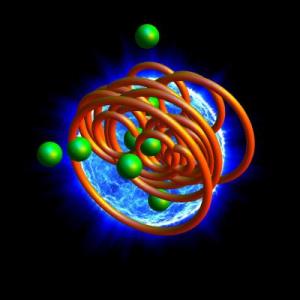Mar 25 2014
Researchers have developed a new mathematical framework capable of describing motions in superfluids – low temperature fluids that exhibit classical as well as quantum behavior. The framework was used to lift the veil of mystery surrounding strange objects in superfluid helium (detected ten years ago at Brown University).
The study, conducted by an international collaboration of researchers from the UK, Russia and France is published today in the journal Proceedings of National Academy of Sciences (PNAS).
 This shows vortex rings as the result of vortex multiplication in a quantum fluid. Some electrons are free, some got trapped by one or more vortices. Credit: Gleb and Sofia Berloff, ISM
This shows vortex rings as the result of vortex multiplication in a quantum fluid. Some electrons are free, some got trapped by one or more vortices. Credit: Gleb and Sofia Berloff, ISM
The quantum nature of superfluids manifests itself in the form of quantized vortices, tiny twisters, with the core sizes of the order of an Angstrom (0.1nm – approximately the diameter of an atom) that move through fluid severing and coalescing, forming bundles and tangles. To make these processes even more intricate and distinct from motions in usual classical fluids, these tiny twisters live on the background consisting of a mixture of viscous and inviscid fluid components that constitute superfluid. The mathematical modelling of such complex systems that involve a range of scales is a notoriously difficult problem.
The international team of researchers – Natalia Berloff of the University of Cambridge and Skolkovo Institute of Science and Technology, Marc Brachet of Université Pierre-et-Marie-Curie and Nick Proukakis of Joint Quantum Centre Durham-Newcastle – came up with a novel framework for achieving this task. The team applied their method to elucidate an intriguing phenomenon in liquid helium research.
Electrons immersed in superfluid helium are useful experimental probes. As they move through superfluid they form soft bubbles of about 2 nm in diameter that get trapped by quantized vortices quite similar to how houses and cars become trapped and transported by a tornado. A research team from Brown University led by Professor Humphrey Maris has studied the effect of oscillating pressures on electron bubbles. As pressure decreases below the criticality, the bubble expands and explodes, reaching micron sizes, with the bubble trapped by a vortex exploding at a pressure larger than that for the free bubble. Maris' team also discovered another class of object that existed at very low temperatures only and exploded at even larger pressures. They termed these "unidentified electron objects".
The new approach published in PNAS today allowed the researchers to look at the processes as oscillating pressure was applied to a quantum fluid containing a vortex ring at a range of temperatures. The researchers discovered a novel mechanism of vortex multiplication: the vortex core expands and then contracts, forming a dense array of new vortex rings during the contraction stage. They conjectured that it becomes quite likely that the electron bubble becomes trapped by more than one vortex line, furthermore reducing the pressure change needed for consequent explosions. They have also shown that the mechanism of vortex multiplication is suppressed at higher temperatures, explaining why such objects were found experimentally only at lower temperatures.
Professor Berloff who led the team commented: "It is fascinating to have a tool to look at the dynamics of processes that occur on the Angstrom lengthscales and at ultra-low temperatures in quantum fluids. The mystery of an unidentified electron object is just a teaser problem; we are ready for other challenges."
"Understanding the intricate features of behavior of quantized vortices is one of the grand unsolved problems that can be tackled with this framework," added Professor Proukakis.